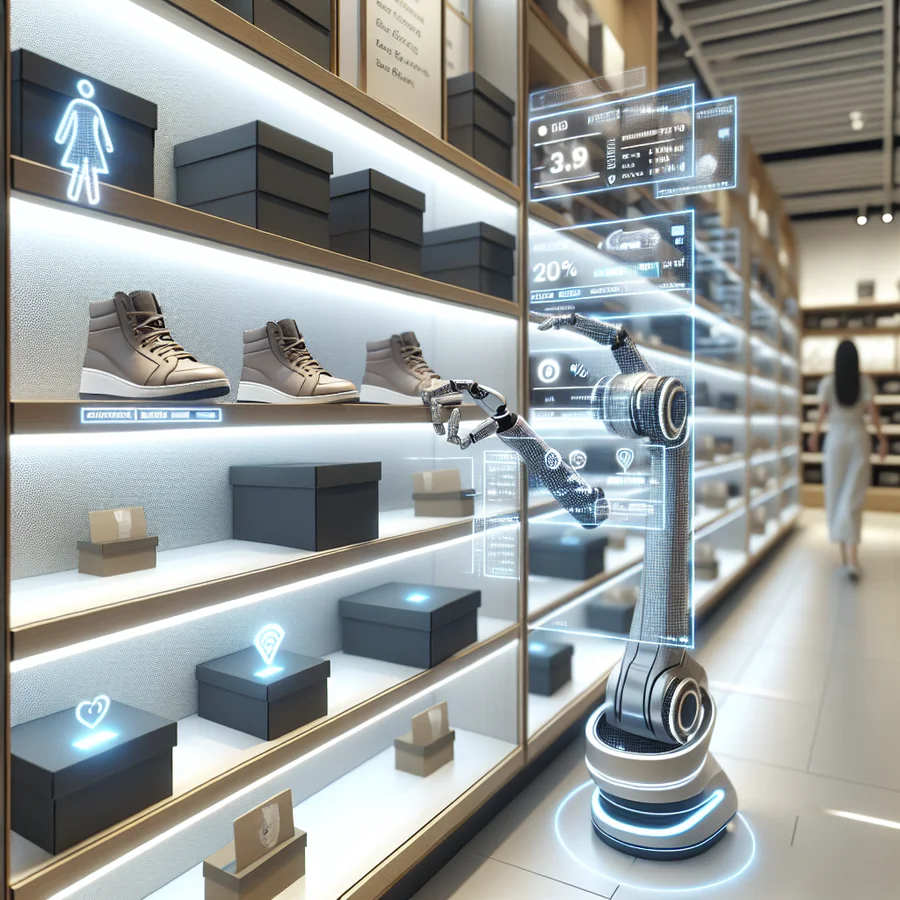AI in Retail: Revolutionizing Inventory Management and Customer Experience
The retail industry is undergoing a massive transformation. Artificial intelligence (AI) is at the forefront of this shift. It’s not just about fancy gadgets. AI is fundamentally changing how retailers manage their inventory and interact with customers. This guide explores how AI in retail is enhancing efficiency and creating better shopping experiences.
Imagine walking into your favorite store and finding exactly what you need, guided by personalized recommendations. Or think about a retailer who always has the right products in stock, thanks to accurate demand forecasting. This is the power of AI in retail. It’s about making things easier and more efficient for both businesses and consumers.
The Impact of AI on Retail Operations
AI is no longer a futuristic concept in retail. It’s a present-day reality. Retailers are using AI to streamline operations, optimize inventory, and personalize customer interactions. This leads to increased efficiency, reduced costs, and improved customer satisfaction.
Better Customer Insights with AI
Understanding your customers is crucial in retail. AI provides retailers with deeper insights into customer behavior and preferences. By analyzing vast amounts of data, AI algorithms can identify patterns and trends that would be impossible for humans to detect manually.
For example, Tractor Supply Co. uses an AI-powered tech assistant called “Gura.” Store associates use Gura to provide high-quality service to customers. If a customer needs dog food for sensitive skin, Gura can quickly identify the best options, check inventory levels, and provide real-time pricing.
AI-Driven Operational Efficiency
Retailers aim to achieve better resource utilization, reduce costs, minimize errors, and increase productivity. Artificial intelligence technologies can streamline various operational processes within an organization, which is particularly useful for leading retailers.
Enhancing Customer Experience with AI
Customer experience is paramount in today’s competitive retail landscape. AI plays a vital role in creating personalized and engaging experiences that keep customers coming back.
Personalized Shopping Experiences
One of the most significant advantages of AI in retail is its ability to offer personalized shopping experiences. AI algorithms analyze customer data, including purchase history, browsing behavior, and preferences, to create individualized recommendations.
Amazon excels at using AI to create personalized recommendations. Their AI software uses machine learning to suggest products based on a customer’s past purchases and the behavior of similar users. This enhances customer satisfaction and drives sales by presenting relevant items to shoppers.
Reminder: Personalization is key to attracting and retaining customers in today’s market. AI makes it possible to deliver tailored experiences at scale.
Automated Customer Service
AI-powered chatbots and virtual assistants are transforming customer service in retail. These tools can handle routine queries, provide product information, and assist with purchases. They offer instant support to customers, improving satisfaction and streamlining the shopping process.
Sephora’s Virtual Artist is a great example. This AI tool allows customers to virtually try on different makeup products. It enhances the online shopping experience, reduces the need for in-person trials, and cuts down on product returns.
AI-Assisted Search and Augmented Reality
With AI-assisted search and augmented reality, customers have new ways to search for and research products before they buy. For instance, AI can analyze images uploaded by users and suggest visually similar products. This has become popular in fashion and home decor, where a consumer might be searching for visually similar products.
Similarly, AI-enhanced AR allows customers to “try on” products before making a purchase. Fashion and beauty brands such as Sephora have had significant initial success with tools allowing customers to see how clothing or makeup might look before committing to a product.
Optimizing Inventory Management with AI
Efficient inventory management is essential for retail success. AI provides retailers with the tools they need to optimize their inventory levels, reduce waste, and meet customer demand.
Predictive Analytics for Demand Forecasting
AI in retail revolutionizes demand forecasting. AI analyzes historical sales data, market trends, and external factors to predict future customer demand with greater accuracy than traditional methods. This helps retailers optimize their stock planning and reduce instances of overstock or stockouts.
Walmart uses AI to predict which products will be in demand during specific seasons. This allows for better stock planning and a more seamless shopping experience for customers. AI enhances Walmart’s daily supply chain workflows and anticipates cycles in demand, especially during peak events or unexpected events in customer traffic.
Note: Accurate demand forecasting is crucial for minimizing waste and maximizing profitability. AI provides the tools to achieve this.
Supply Chain Optimization
AI plays a critical role in managing the backend operations of a retail business, optimizing inventory and supply chain management. By integrating AI technologies into various supply chain functions like supplier management and transportation logistics, organizations can optimize inventory, increase visibility, lower costs and reduce errors.
Swedish fashion retailer H&M leverages AI to optimize its supply chains, analyze trends, and forecast demand. This enables the company to quickly respond to changing market demands and minimize lead times. The AI tool captures data from search engines and blogs, allowing algorithms to predict and analyze trends.
AI-Driven Inventory Management
AI-driven inventory management streamlines the process, allowing retailers to maintain optimal inventory levels across all channels.
- Demand Forecasting: AI can predict future demand by analyzing historical sales data, current trends, and external factors such as seasonality.
- Automated Replenishment: With predictive analytics, AI helps retailers automate replenishment orders, ensuring popular products remain in stock while reducing the risk of unsold inventory.
- Omnichannel Inventory Visibility: AI enables real-time inventory tracking across all retail channels, including online, in-store, and warehouses.
- Supply Chain Optimization: AI-powered supply chain analytics allows retailers to manage logistics and distribution effectively.
By implementing these strategies, retailers can achieve more responsive supply chains and reduce stockouts, ultimately improving customer satisfaction and profitability.
AI-Enhanced Fraud Detection and Security
The retail industry uses artificial intelligence to enhance the capabilities of systems designed to detect and prevent fraud. AI can be especially useful in cybersecurity and financial transactions.
Fraud Prevention
Online and in-store fraudulent transactions are on the rise. Retailers must ensure that all purchases are authentic. AI algorithms analyze transaction patterns and identify potentially fraudulent transactions in real time, protecting both the retailer and the customer.
Alibaba, the Chinese e-commerce giant, uses AI to analyze user behavior and identify potential fraudulent transactions. This safeguards the interests of both the company and its customers.
In-Store Surveillance
Security for brick-and-mortar stories has received a major boost from the use of AI-powered surveillance systems. These systems analyze video feeds in real time, flagging suspicious activities or behaviors.
Facial recognition technology can identify known shoplifters and alert security teams, enhancing overall store security. Retailers like Walmart and Target have invested in AI-based surveillance to minimize losses due to theft and enhance the safety of their stores.
Reminder: AI-powered cameras at self-checkouts can monitor human behavior and alert employees of skipped merchandise scans. This helps prevent both accidental and intentional theft.
The Rise of AI-Powered Retail Analytics
Modern-day retail is all about analytics. Data analysis can deliver valuable insights to enable business executives to make data-driven decisions, optimize retail operations, and improve customer retention.
Data-Driven Decision Making
AI-driven analytics provide retailers with valuable insights into customer behavior by allowing for data-driven decision-making and the analysis of customer interactions. Retailers can then optimize pricing strategies, marketing campaigns, and product placements for their customers, based on this data.
British retailer Tesco uses AI to analyze customer data and personalize promotions, resulting in increased customer engagement and loyalty. The company argues that AI is key to maintaining their growth.
Dynamic Pricing
The ability to adjust prices in real time – based on consumer demand, competitor pricing, or even inventory levels – is a competitive advantage for many retailers. Applying AI allows retailers to use dynamic pricing to remain competitive and maximize their profits.
Delta Air Lines and Amazon are great examples of the use of AI for dynamic pricing. Both use AI algorithms to adjust their prices, ensuring they capture the maximum value from transactions and produce the desired outcomes for the business.
Technologies Deployed in AI for Retail
AI for retail uses various technologies and data ecosystems. These tools are used to enhance operations, customer experience and business-wide decision making. Multiple technologies are often used in tandem depending on a particular retailer’s needs. Some of the most common AI technologies used for retail operations include:
- Data management systems
- Big data and predictive analytics
- Machine learning (ML)
- Natural language processing
- Computer vision
- RPA
- IoT
Data Management Systems
Data management systems are the backbone of AI in retail. These systems allow for the collection, storage and management of vast amounts of data from multiple sources, providing the foundation for data analytics and machine learning algorithms. These systems help ensure the quality, consistence and accessibility of data used to train an A. Such data management systems include:
- Data warehouses, data lakes and data lakehouses: Centralized repositories that store data collected from various sources including sales, customer interactions and supply chain operations
- Data integration tools: Which extract, transform and load data from various sources into a data storage repositories, ensuring data quality and consistency for AI applications
- Cloud data platforms: Which provide the infrastructure for storing, processing and analyzing large datasets, enabling scalable AI applications capable of analyzing data as it’s generated
Big Data and Predictive Analytics
AI systems in retail depend on massive amounts of data to make accurate predictions and decisions. Big data tools and predictive analytics interpret this data, extracting meaningful insights. For example, these tools are used to perform:
- Customer behavior analysis: In which AI analyzes customer purchase patterns, preferences and interactions across channels to provide personalized experiences and targeted marketing
- Sales forecasting: In which predictive analytics helps retailers anticipate trends and align inventory with expected demand
Automation
Automation processes and software perform routine tasks, reducing human error and expanding a retail organization’s capacity. These technologies can be used in multiple areas of a business, from inventory management and automated catalog updates to wide-scale business process automation.
- Robotic Process Automation (RPA): Automates more complex multistep tasks and workflows. RPA can be used in areas like inventory management and supply chain automation to track and update inventory levels or manage the fulfillment process.
- Voice automation: Allows machines to understand and respond to human voices. These technologies are increasingly used for voice assistants like Alexa, which have become more popular as a retail platform.
Machine Learning and Deep Learning
Machine learning is one of the backbones of AI applications in retail. ML algorithms enable systems to learn from data and improve their performance over time without being specifically programmed for a task. Machine learning powers:
- Recommendation engines: Suggest personalized products to customers based on their browsing behavior and purchase history.
- Demand forecasting: Analyzes historical sales data, market trends and other factors to predict future demand and optimize product stock levels
- Dynamic pricing: Adjusts prices in real-time based on demand, competition and other factors
Natural Language Processing (NLP) and Computer Vision
Natural language processing (NLP) enables AI systems to “understand” and generate human language. Computer vision allows those systems to understand and interpret visual data from the physical world, making it a useful technology for enhancing in-store and online shopping experiences. Often, NLP and computer vision technology are used in retail for:
- Chatbots and virtual assistants: Use NLP to engage with customers, answer queries and guide users through a shopping experience
- Sentiment analysis: A process through which NLP tools analyze customer reviews, chatbot communications and social media posts to measure customer sentiment and provide insights into consumer preferences
- Visual search: Allows customers to search for products by uploading images and finding similar items based on visual characteristics
- Automated inventory management: A process through which cameras and sensors detect stock levels in a store or warehouse, alerting staff when products need to be replenished
IoT (Internet of Things)
IoT devices generate real-time data from sensors, cameras and smart devices, which AI systems can analyze to optimize retail operations on the customer experience. These systems can be used to power:
- In-store analytics: In which IoT sensors track foot traffic and customer engagement levels to optimize store layouts and marketing strategies
- Ecommerce logistics: In which sensors track delivery trucks of other logistics vehicles, providing real-time updates to customers or businesses
Benefits of AI in Retail
The integration of AI and associated technologies into the retail sector has the capacity to enhance both the customer experience and business operations. Some common benefits of the technology include:
- Increased efficiency
- Enhanced customer experience
- Cost reduction
- Data-driven decision making
- Advanced demand forecasting
- Price optimization
- Enhanced customer behavior analysis
By automating routine tasks, AI allows retailers to focus on more strategic activities. Dynamic personalization and instant support foster better relationships between brands and customers. AI optimization processes can reduce waste and lower operational costs. Retailers gain access to real-time data and actionable insights for informed decisions. Accurate demand forecasting helps adapt to changing conditions and reduce waste. Dynamic tools determine effective pricing strategies to maximize revenue. Analyzing customer sentiment provides valuable insights for increasing customer value.
Ethical Considerations and the Use of AI
While AI offers numerous benefits, it’s crucial to address ethical considerations. Privacy concerns, algorithmic biases, and potential job displacement need careful consideration. Striking the right balance between leveraging AI for efficiency and ensuring its ethical use is crucial for the sustainable growth of AI in the retail sector.
Consumers need to be aware of what data retailers collect and have the option to give or deny consent. Efforts to reskill and upskill affected workers should accompany the implementation of AI technologies.
Best Practices for Implementing AI in Retail
Incorporating AI into a retail business requires more than deploying new technology. Successful implementation demands a thoughtful strategic approach that is both comprehensive and adaptable based on company needs. Some common best practices include:
- Starting with a clear strategy
- Using high-quality data
- Choosing the right AI tools and partners
- Prioritizing customer experience
- Continuously monitoring and maintaining AI models
- Practicing good data governance
Retail businesses just beginning an AI initiative might start with a pilot focusing on a high-impact area, such as personalized marketing or automated inventory management. By prioritizing use cases offering the highest return on investment, an organization is more likely to see tangible results.
Conclusion
AI in retail is transforming the industry. From personalized shopping experiences to optimized inventory management, AI offers retailers powerful tools to enhance efficiency, improve customer satisfaction, and drive growth. By embracing AI strategically and addressing ethical considerations, retailers can unlock its full potential and thrive in the evolving retail landscape. The future of retail is intelligent, personalized, and efficient, all thanks to the power of AI.
FAQs
How does AI personalize the shopping experience?
AI algorithms analyze customer data, including purchase history, browsing behavior, and preferences, to create individualized recommendations and targeted marketing.
What are the benefits of AI in inventory management?
AI optimizes inventory levels, reduces waste, and improves demand forecasting, leading to increased efficiency and reduced costs.
How does AI enhance customer service in retail?
AI-powered chatbots and virtual assistants provide instant support, answer queries, and assist with purchases, improving customer satisfaction.
What are the ethical considerations of using AI in retail?
Privacy concerns, algorithmic biases, and potential job displacement need careful consideration to ensure the ethical use of AI.
How can retailers get started with AI implementation?
Start with a clear strategy, use high-quality data, choose the right AI tools and partners, and prioritize customer experience.






